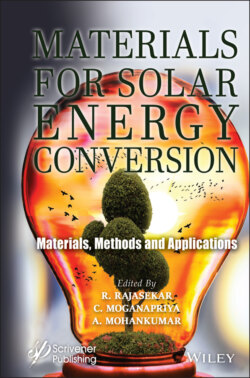Читать книгу Materials for Solar Energy Conversion - Группа авторов - Страница 14
1.1 Introduction
ОглавлениеEnergy usage plays a vital role in last few decades due to rapid changes in environmental conditions precisely global warming effects which lead to energy demand. Energy acts as an important role in identifying the economic development of developing nations. Eliminating those problems constantly imposes us toward alternative energy sources [1]. The World Health Organization published the statistics; there are major remarkable climatic changes in between 2030 and 2050 which cause deaths approximately 250,000 per year. Presently, 80% of conventional energy sources are reported as global energy consumption [2]. The renewable energy utilization estimated in the year 2020 is approximately 8.65%. In the year 2050, this source of energy may tend to increase around 9.82% in the energy demand. The global industrial energy consumption by fuel is shown in Table 1.1.
Renewable energy sources are free from carbon-di-oxide emission such as solar energy, tidal energy, biomass energy, and wind energy [3]. There is a higher growth in fuel prices and climatic constraints, and industrial sectors are inclined to the renewable energy sources instead of fossil fuel usages. Hence, new advanced technologies are introduced to replace conventional energy sources in industries and some other appliances also [4]. Among the various different types of renewable energy, solar energy is free, clean, and non-pollutant environmental source that has to be implemented in industries. Generally, there is a large quantity of solar energy is available in our earth, easy to extract from sun’s radiation and significantly reduction takes place in green house effects. However, more number of attempts has been made to produce solar energy through photoelectric conversion, photo thermal conversion, photoelectric-photothermal conversion, photochemical conversion, sun trackers and giant mirrors, etc.
According to International Renewable Energy Policy, the renewable energy generation capacity is accounted in total as 2,537 GW in global energy consumption by the end of 2019 [5]. The net increase of global renewable energy generation capacity is 176 GW (7.4%) in 2019. In this total renewable energy sources, solar energy continued to be a prominent energy generation that takes place as 23% approximately and 20% rise in the year 2019 compared with previous assessment year of 2018.
Table 1.1 Global industrial energy consumption pattern by fuel in 2020 and 2050 (in terms of %).
| Sources of energy | 2020 (%) | 2050 (%) |
| Liquids | 26.3 | 25.86 |
| Natural gas | 23.27 | 23.71 |
| Coal | 25.97 | 24.43 |
| Electricity | 15.77 | 16.16 |
| Renewable | 8.65 | 9.82 |
